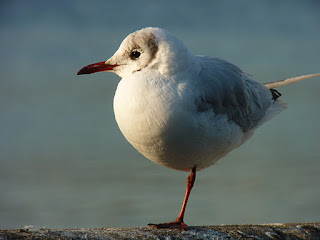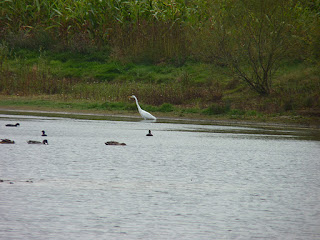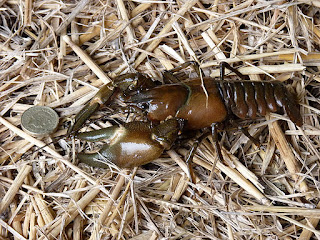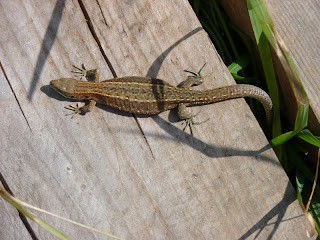I was in full twitching mode yesterday. 2011 has not been one of my better birding years. I seem to have put in a lot of effort for not too much reward.
Admittedly there have been some real highs including our holiday to Mallorca and the 4 day trip to Northumberland and the Farne Islands. Obviously there have been quite a few good days and some good birds seen.
But this year seems to have been hard going - not just for me, but in general speaking to other local birders, they too have struggled.
So as I always try to do at this time of year, I planned a day out to try and give my final year tally a boost.
Norfolk seemed a good bet as there seemed an abundance of decent birds around.
So an early start saw me arrive at RSPB Buckenham Marshes, where the regular wintering flock of Taiga Bean Geese had recently arrived. and these could be seen albeit rather distantly grazing on the meadows. More interesting though was the adult LESSER WHITEFRONTED GOOSE that was loitering in their midst. Often these birds are considered to be escapes, but this is the second winter on the trot that this endearing small goose has appeared with the Bean Geese, so as far as I'm concerned as sure as you can be of a genuine wild bird.
Other birds around the site included a large flock of Golden Plover, Lapwings, Curlews, Ruff, Redshanks and Snipe in the wader department. A Marsh Harrier flew over and large flocks of Wigeon allowed reasonably close approach.
Next it was a trip up to the North Coast and Cley Marshes in particular.
After paying my £5 (gone up again I see ! - Birding used to be such a cheap pastime - not any more !!) I found out the bird I had come to see was not even on the reserve. It had moved onto Arnolds Marsh.
So a quick trek up the East Bank to join up with the crowd already there had me watching a juvenile WESTERN SANDPIPER wandering around with the local Dunlins. Now this really is a rare bird in Britain, something like only the 7th ever record.
Other birds out on the marsh included Curlews, Black-tailed Godwits, Grey Plovers Ruff, Shelducks and a large flock of Linnets.
A brief seawatch produced little other than a lone Red-throated Diver on the sea with a couple of others flying past. A surprise to me was a large flock of Teal just off-shore- never seen them on anything other than freshwater. A Common Seal bobbed about just off the beach.
Back at the visitor centre hundreds of Brent Geese covered nearby fields including a few right by the roadside.
I decided to stop off next at Wells-next-the-Sea and have some Fish and Chips while trying to find the reported Red-necked Grebe in the harbour.
This didn't work out as the Grebe was nowhere to be seen, just a lone Great-crested and 4 Little Grebe amongst the numerous Gulls who ended up having most of my lunch, as to be honest, considering the fish was landed on the otherside of the road to the chipshop, it was some of the worst I've ever had.
Holkham was my next destination (more money to park!), where I took a walk down to the dunes in search of some recent Shorelarks. The weather then turned against me and it became dark very quickly, so needless to say I didn't find the Larks. Some consolation though was the 50 or so Snow Buntings, which were probably the ones I had seen here a month or so ago.
All in all my day out probably reflected my birding year with some real highs mixed in with a few disappointments.
Lets hope for better in 2012.
Happy new year to any one who takes the time to drop by.
Admittedly there have been some real highs including our holiday to Mallorca and the 4 day trip to Northumberland and the Farne Islands. Obviously there have been quite a few good days and some good birds seen.
But this year seems to have been hard going - not just for me, but in general speaking to other local birders, they too have struggled.
So as I always try to do at this time of year, I planned a day out to try and give my final year tally a boost.
Norfolk seemed a good bet as there seemed an abundance of decent birds around.
So an early start saw me arrive at RSPB Buckenham Marshes, where the regular wintering flock of Taiga Bean Geese had recently arrived. and these could be seen albeit rather distantly grazing on the meadows. More interesting though was the adult LESSER WHITEFRONTED GOOSE that was loitering in their midst. Often these birds are considered to be escapes, but this is the second winter on the trot that this endearing small goose has appeared with the Bean Geese, so as far as I'm concerned as sure as you can be of a genuine wild bird.
Other birds around the site included a large flock of Golden Plover, Lapwings, Curlews, Ruff, Redshanks and Snipe in the wader department. A Marsh Harrier flew over and large flocks of Wigeon allowed reasonably close approach.
 |
| Wigeon |
After paying my £5 (gone up again I see ! - Birding used to be such a cheap pastime - not any more !!) I found out the bird I had come to see was not even on the reserve. It had moved onto Arnolds Marsh.
So a quick trek up the East Bank to join up with the crowd already there had me watching a juvenile WESTERN SANDPIPER wandering around with the local Dunlins. Now this really is a rare bird in Britain, something like only the 7th ever record.
Other birds out on the marsh included Curlews, Black-tailed Godwits, Grey Plovers Ruff, Shelducks and a large flock of Linnets.
A brief seawatch produced little other than a lone Red-throated Diver on the sea with a couple of others flying past. A surprise to me was a large flock of Teal just off-shore- never seen them on anything other than freshwater. A Common Seal bobbed about just off the beach.
Back at the visitor centre hundreds of Brent Geese covered nearby fields including a few right by the roadside.
I decided to stop off next at Wells-next-the-Sea and have some Fish and Chips while trying to find the reported Red-necked Grebe in the harbour.
This didn't work out as the Grebe was nowhere to be seen, just a lone Great-crested and 4 Little Grebe amongst the numerous Gulls who ended up having most of my lunch, as to be honest, considering the fish was landed on the otherside of the road to the chipshop, it was some of the worst I've ever had.
Holkham was my next destination (more money to park!), where I took a walk down to the dunes in search of some recent Shorelarks. The weather then turned against me and it became dark very quickly, so needless to say I didn't find the Larks. Some consolation though was the 50 or so Snow Buntings, which were probably the ones I had seen here a month or so ago.
All in all my day out probably reflected my birding year with some real highs mixed in with a few disappointments.
Lets hope for better in 2012.
Happy new year to any one who takes the time to drop by.














































